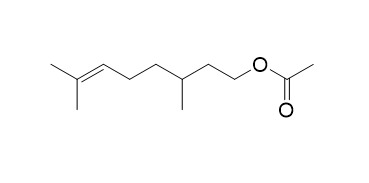Citronellyl acetate
Citronellyl acetate(CAT) shows antinociceptive properties on acute pain and shows that, at least in part, TRPV1, TRPM8, ASIC, glutamate receptors, PKC and PKA participate in CAT’s antinociceptive mechanism.
Inquire / Order:
manager@chemfaces.com
Technical Inquiries:
service@chemfaces.com
Tel:
+86-27-84237783
Fax:
+86-27-84254680
Address:
1 Building, No. 83, CheCheng Rd., Wuhan Economic and Technological Development Zone, Wuhan, Hubei 430056, PRC
Providing storage is as stated on the product vial and the vial is kept tightly sealed, the product can be stored for up to
24 months(2-8C).
Wherever possible, you should prepare and use solutions on the same day. However, if you need to make up stock solutions in advance, we recommend that you store the solution as aliquots in tightly sealed vials at -20C. Generally, these will be useable for up to two weeks. Before use, and prior to opening the vial we recommend that you allow your product to equilibrate to room temperature for at least 1 hour.
Need more advice on solubility, usage and handling? Please email to: service@chemfaces.com
The packaging of the product may have turned upside down during transportation, resulting in the natural compounds adhering to the neck or cap of the vial. take the vial out of its packaging and gently shake to let the compounds fall to the bottom of the vial. for liquid products, centrifuge at 200-500 RPM to gather the liquid at the bottom of the vial. try to avoid loss or contamination during handling.
Phytomedicine.2021, 83:153483.
Am J Chin Med.2016, 44(8):1719-1735
J of Pharmaceutical Analysis2020, doi: 10.1016
Molecules.2021, 26(4):1084.
Br J Pharmacol.2024, 181(24):5009-5027.
SBRAS2016, 12
J Pharm Biomed Anal.2017, 140:274-280
Bull. Pharm. Sci., Assiut University2020, 43(2):149-155.
Malaysian J of Fundamental and Applied Sciences 2018, 14(3):368-373
J Ginseng Res.2023, 47(4):593-603.
Related and Featured Products
Chem Biol Interact, 2013, 203(3):573-579.
TRP and ASIC channels mediate the antinociceptive effect of citronellyl acetate.[Reference:
WebLink]
Citronellyl acetate (CAT), a monoterpene product of the secondary metabolism of plants, has been shown in the literature to possess several different biological activities. However, no antinociceptive abilities have yet been discussed. Here, we used acute pain animal models to describe the antinociceptive action of CAT.
METHODS AND RESULTS:
The acetic acid-induced writhing test and the paw-licking test, in which paw licking was induced by glutamate and formalin, were performed to evaluate the antinociceptive action of CAT and to determine the involvement of PKC, PKA, TRPV1, TRPA1, TRPM8 and ASIC in its antinociceptive mechanism. To do so, we induced paw-linking using agonists.
CAT was administered intragastrically (25, 50, 75, 100 and 200 mg/kg), and the two higher doses caused antinociceptive effects in the acetic acid model; the highest dose reduced pain for 4 h after it was administered (200 mg/kg). In the formalin test, two doses of CAT promoted antinociception in both the early and later phases of the test. The glutamate test showed that its receptors are involved in the antinociceptive mechanism of CAT. Pretreatment with CAT did not alter locomotor activity or motor coordination. In an investigation into the participation of TRP channels and ASICs in CAT’s antinociceptive mechanism, we used capsaicin (2.2 μg/paw), cinnamaldehyde (10 mmol/paw), menthol (1.2 mmol/paw) and acidified saline (2% acetic acid, pH 1.98). The results showed that TRPV1, TRPM8 and ASIC, but not TRPA1, are involved in the antinociceptive mechanism. Finally, the involvement of PKC and PKA was also studied, and we showed that both play a role in the antinociceptive mechanism of CAT.
CONCLUSIONS:
The results of this work contribute information regarding the antinociceptive properties of CAT on acute pain and show that, at least in part, TRPV1, TRPM8, ASIC, glutamate receptors, PKC and PKA participate in CAT’s antinociceptive mechanism.
Journal of Agricultural & Food Chemistry, 2003, 51(13):3840.
Sensory and instrumental evaluation of catnip (Nepeta cataria L.) aroma.[Pubmed:
12797753]
METHODS AND RESULTS:
The present study investigates the composition of volatile constituents and sensory characteristics of catnip (Nepeta cataria L.) grown in Lithuania. Hydrodistillation, simultaneous distillation-solvent extraction, static headspace, and solid phase microextraction methods were used for the isolation of aroma volatiles. Geranyl acetate, Citronellyl acetate, citronellol, and geraniol were the major constituents in catnip.
CONCLUSIONS:
Differences in the quantitative compositions of volatile compounds isolated by the different techniques were considerable. A sensory panel performed sensory analysis of the ground herb, pure essential oil, and extract; aroma profiles of the products were expressed graphically, and some effects of odor qualities of individual compounds present in catnip on the overall aroma of this herb were observed.



